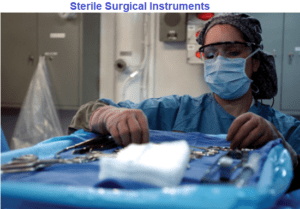Overview of Microbial Growth control
Introduction
For personal hygiene, washing our hands, taking regular showers or baths, brushing our teeth with fluoride toothpaste, and using an underarm deodorant are common practices we use to control microorganisms on our bodies. In our homes, we try to keep microbes in check by cooking and refrigerating foods, cleaning our kitchen counters and bathrooms with disinfectant chemicals, and washing our clothes with detergents.
Microbial Growth Can Be Controlled in Several Ways:
The effective control of disease-causing microbes is important not only in hospitals and in healthcare facilities but also in the food industry, in restaurants, and in our own homes. In all these environments, control requires an understanding of the physical and chemical methods used to limit microbial growth and or microbial transmission.
Sterilization and Sanitization are key to good public health
Before we examine the types of physical and chemical methods employed in microbial control, we need to establish some basic vocabulary used by health officials and sometimes misused by the public when talking about microbial control in the environment.
Sterilization
In microbiology, sterilization involves the destruction or removal of all living microbes, spores, and viruses on an object or in an area. For example, in a surgical operation, the surgeon uses “sterile” instruments previously treated in some way to kill any microbes present on them. Agents that kill microbes are microbicidal (-cide = kill) or more simply called “germicides.” If the agent specifically kills bacterial cells, it is bactericidal; if it kills fungi, it is fungicidal.

However, as soon as the sterile material or object is exposed to the air and the surrounding environment, the material or object will again become contaminated with microbes in the air or the surrounding area. A slightly different meaning of sterilization is used in the food industry. Here, sterilization can simply refer to the elimination of human pathogens.
For example, during the canning process for vegetables and fruits, companies carry out commercial sterilization, which kills all the pathogens in the product. Some non pathogenic microbial species might still be present.
Sanitization
More often, in our daily experiences we are likely to encounter materials for which microbial populations have been reduced or their growth has been inhibited.
Sanitization involves those procedures that reduce the numbers of pathogenic microbes to a level considered safe by public health standards. The process does not sterilize and, given enough time, microbes and potential pathogens will settle and grow on the sanitized object. Thus, public health depends on good sanitary practices at home and in the workplace.
Restaurants use physical and chemical procedures to sanitize cooking utensils and work surfaces. A toilet in a public restroom might have been “sanitized for your protection”; however, in a very short time, these objects can again be contaminated with microbes and pathogens from the environment or from another person. Many sanitizing agents, such as the disinfectants and antiseptics, are said to be microbiostatic (-static = remain in place); that is, they reduce microbial numbers or inhibit their growth. Again, specific agents can be bacteriostatic or fungistatic.
Physical Methods and Chemical Agents to Control Microbes
The physical methods and chemical agents used to control microbial growth usually exert their effect by either targeting specific cellular structures or interfering with metabolic activities. The bacterial cell envelope and microbial proteins and nucleic acids are prime targets.
The Bacterial Cell Envelope
Some control methods kill or limit the growth of bacterial cells by targeting the cell envelope, that is, the cell wall and cell membrane. A variety of chemical agents can damage or break the structure of the cell wall. Lacking the structural integrity of the wall, osmotic lysis will occur and the cell will burst.
The cell membrane, being composed of phospholipids and proteins, is very susceptible to physical or chemical methods that disrupt membrane structure or interfere with its function as a selectively permeable barrier. This might involve dissolving of the phospholipid bilayer or inactivating (denaturing) membrane proteins. The result is loss of permeability control, which again will lead to cell death.
Proteins and DNA
Proteins are the workhorses in all cells, both as structural components and functional factors. When heat, pH, or salt conditions vary from their normal physiological range, the three-dimensional structure of proteins is altered, and they unfold from their active state. This denaturation of a protein, such as an enzyme, can inactivate the protein, inhibiting cell function and perhaps leading to cell death.
Like proteins, nucleic acids are subject to structural and functional changes if environmental conditions become extreme. Several physical and chemical methods will disrupt DNA and RNA structure, interfere with cell growth and division, or prevent gene expression. Any permanent inactivation of the nucleic acids will result in death of the cell.
Reference and sources
- https://drrajivdesaimd.com/2013/03/20/sanitation/
- https://www.openaccessgovernment.org/bacterial-cell-biology-2/40219/
- http://custom.jblearning.com/microbiology/10e/KC.aspx?chapter=7
- https://bio.libretexts.org/Bookshelves/Biochemistry/Book%3A_Biochemistry_Free_For_All_(Ahern_Rajagopal_and_Tan)/02%3A_Structure_and_Function/203%3A_Structure__Function-_Proteins_I
- https://www.researchgate.net/publication/315804456_STERILISATION_AND_DISINFECTION
- https://www.bhu.ac.in/research_pub/jsr/Volumes/JSR%20Vol%2063%202019/4.%20Dr.%20Ankush%20Mini%20Review_Final%20Proof.pdf
Also Read:
- Third Golden Age of Microbiology
- what is microbiology?
- Probiotics: Introduction, Development and Uses in agriculture
- Different types of Pathways for ATP Production
- Viruses Arise from Genetic Recombination and Mutation
- Comparison Between the Domains Bacteria, Archaea, and Eukarya
- Reverse Transcription Polymerase Chain Reaction (RT-PCR)
- Microbiology Disciplines: Bacteria, Viruses, Fungi, Archaea and Protists
- Bacterial Growth Curve: Definition, Phases and Measurement
